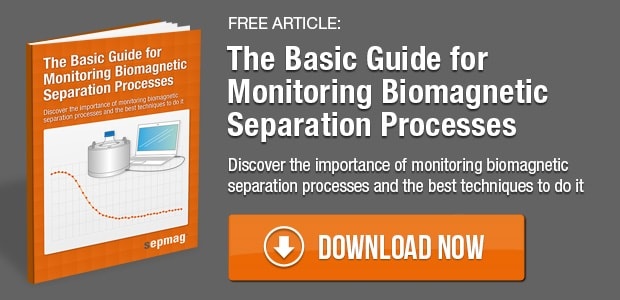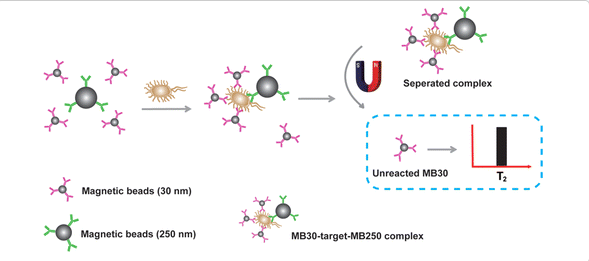In an attempt to improve upon current options for detecting pathogens and viruses, scientists in Beijing, China have created a new method that employs a combination of magnetic separation (MS) and magnetic relaxation switching (MRS). This new MS-MRS sensor is more rapid and portable than previous methods such as ELISA and PCR.
Magnetic relaxation switching is used to measure the extent of magnetic particle aggregation in a sample. When magnetic particles are exposed to an external magnetic field, they begin to aggregate and form clumps. These clumps of magnetic particles then induce a small local heterogeneous magnetic field that changes the transverse relaxation time (T2) of nearby water molecules. By measuring the ΔT2 of those nearby water molecules, the extent of aggregation can be elucidated.
In this work, the scientists used MRS combined with antigen-coated magnetic beads of two different sizes. An optimized amount of 250nm (MB250) and 30nm (MB30) magnetic beads capable of binding to the pathogen/target of interest were used. When the target is present in a sample, both of the bead sizes bind and form a MB250-target-MB30 complex. An excess amount of unbound MB30 always remains.
Magnetic materials of different sizes have different saturation magnetizations. The MB250 has a higher saturation magnetization than MB30, which means that in the presence of a small 0.01T magnetic field the MB250 beads can be separated from solution, but the MB30 beads are unaffected.
When the 0.01T field is applied to the sample, the MB250-target-MB30 complex is separated out of the solution and the unbound MB30 remains. The T2 relaxation time of the water particles around the remaining MB30 is measured. In the absence of a pathogen, no immune binding occurs, no complex forms, and all of the MB30 particles lead to a low ΔT2. When a pathogen is present, the MB250-target-MB30 complex is formed and removed from solution. The small amount of unbound MB30 particles remaining lead to a high ΔT2. Therefore, the intensity of the ΔT2 signal is a good quantitative readout of the amount of pathogen in solution.
This MS-MRS sensor has a high signal-to-noise ratio, and its ease of use makes it a promising tool in the detection of pathogens in clinical point-of-care settings. The sensor was also successfully used to detect the presence of pathogens in milk, which indicates a potential use in food safety and environmental monitoring. Further information about optimization parameters and limits of detection can be found in the original article cited below.
One-Step Detection of Pathogens and Viruses: Combining Magnetic Relaxation Switching and Magnetic Separation. Yiping Chen et al. ACS Nano, 2015, 9 (3), pp 3184–3191. DOI: 10.1021/acsnano.5b00240.
Related news:
- Reversibly Binding Immunomagnetic Beads
- The 20th Annual International Conference on Magnetism
- Tumor Depletion with Combined Magnetic Hyperthermia and Photodynamic Therapy





